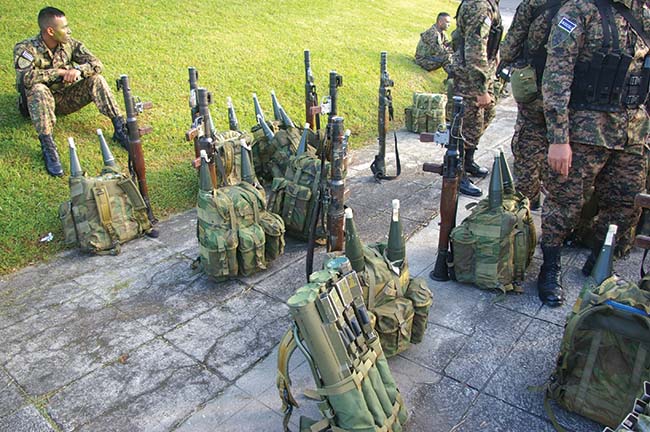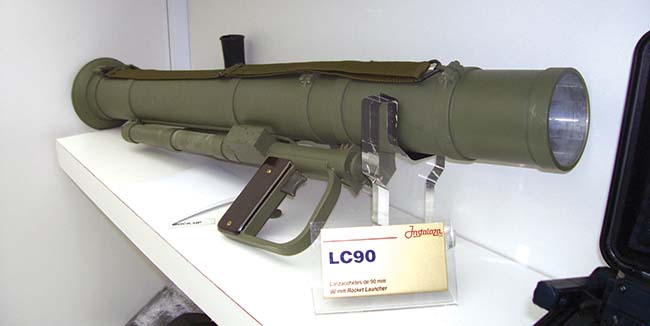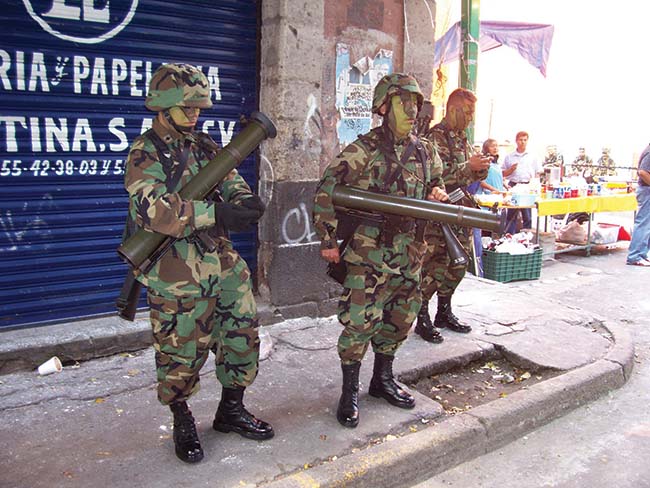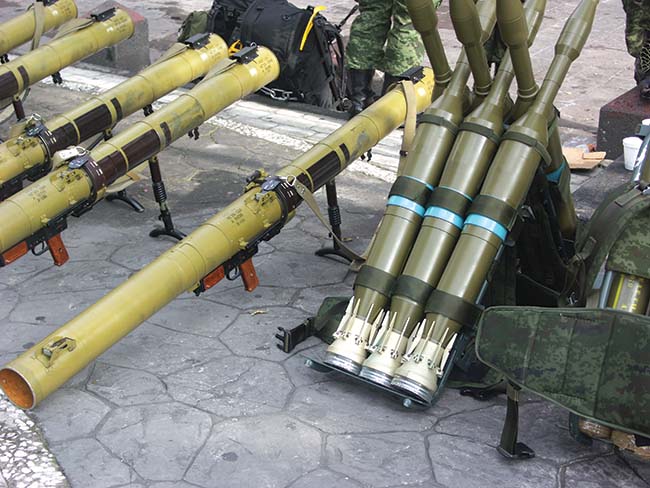ABOVE: Mexican soldier atop of a Humvee with a RL-83 Blindicide. This is an obsolete AT weapon, but still applicable to the potential threats faced by Mexico. (J. Montes)
About two years ago, Salvadorian military intelligence was preoccupied with reports that the brutal MS-13 gang had obtained around 100 M72 Light Antitank Weapons (LAW). Fortunately, the rockets have not been used against any targets within the country. The weapons most likely have been passed over to the Mexican cartels as it is reported that the MS-13 has forged a partnership with Mexican organized crimes syndicates. MS-13 is said to have supplied the Mexican Zetas with advanced weapons. Central American gang member have attended military-style training, and have acted as middlemen between regional militaries and drug traffickers.
A few rockets could have come from the ill fated ATF Castaway Operation in Honduras, the little known sideshow of the Fast and Furious debacle, which ended up supplying weapons to MS-13 and other Central American criminal organizations. The weapons could also come from local arsenals as well. What is certain is that around 2007, a number of M72 rocket launchers had gone missing from the elite Honduran 2nd Infantry Battalion (parachute). Some of the rockets were recovered in Mexico and Colombia 12 months later. The LAWs belonged to a lot of 50 examples delivered to the elite TESON (Honduran Ranger) training unit in 1992; of the fifty, 26 could not be accounted for. The Hondurans were also missing a number of M433 40mm cartridge high-explosive dual purpose (HEDP) grenades from a stockpile transferred to Honduras in 1985.

The M72 is useful against light armor at very short range, and often used to soften up stronghold positions. The U.S. delivered in excess of 700 examples to the Salvadorian Army, so it was used widely by Salvadorian forces fighting the FMLN guerrillas during the 1980s. Several hundred were also delivered to the Honduran counterpart. Dozens were lost and captured by guerrilla forces, and many others were lost to the Contras in Nicaragua. M72 LAWs and M16s came from Vietnam to the hands of revolutionary groups in the region. It is used today by the Salvadorian and Honduran Army in quantities, and also found in smaller quantities in Panama, Costa Rica and Guatemala.
Well known to anyone who has spent any time in the U.S. Army, the M72 is a 66mm rocket contained within a double fiberglass tube. When the outer tube is extended, the firing mechanism is activated, and the extended tube length becomes the launching platform. The rocket is retained in the inner tube, along with the firing pin itself. When fired, the rocket extends stabilizing fins to slide the warhead to its target. The launcher tube is then discarded. The rocket weighs 2.5 kg and gives a 250 mm armor penetration at 200 meters. The LAW has evolved in several improved versions, and has also inspired a number of other similar rockets. The AT-4 is one example inspired by the M72, but it is not a common weapon found in the region; however, the Soviet RPG-18 equivalent has been. The 64mm rocket, with a 200 m range, could defeat up to 375 mm armor, and found favor with the FMLN guerrillas, Panamanian Defense Forces, and Sandinista Army. The last variation of the original LAW is the M72A7, adopted by the U.S. Marines, and introduces several improvements over the earlier models. However, only the M72A2 and A3 variants are found in Central America. The M72 lacks the punching power to destroy an MBT, but has enough power to destroy any vehicle, door, and small position.

Although the M72 is highly sought by criminal enterprises given its light weight, powerful warhead, and easy handling, its Russian somewhat equivalent, the RPG-7, is even more common. Unlike the M72 or the RPG-18, the RPG-7 is not a disposable tube, but a reusable and reloadable recoilless rifle firing more powerful ordnance. Numbers of them are being acquired by cartels; many coming from military warehouses in Central America and others have become available in the black market from former guerrilla holdings. For instance, in early 2012, it came to light that two years earlier the Honduran Army had lost 22 RPG-7s from the Army Logistical Support Command. Quantities of anti-tank missiles and launchers have been confiscated in Mexico and Guatemala, to include seven RPG-7Vs and three RPG-7Bs captured in El Zamorano in 2004, and 72 RPG-7 grenades in Olancho, both in Honduras, in 2007. In March 2011, Honduran authorities seized 25 RPG-7 launchers, along with several assault rifles, in a home in San Pedro Sula, some 240 km from Tegucigalpa. In February 2013, another RPG-7 was found in Olancho. In October 2013, Guatemalan authorities seized 11 pistols, 1 Mini Uzi, two M72A1s and one M72A3 LAW, 1 RPG-7, grenades, rifles, ammunition, and more.
The RPG-7 was used extensively by guerrilla movements in El Salvador, Nicaragua and Guatemala, and it is said that Israel supplied the Contras with over a hundred RPG-7s recovered from PLO camps in 1982. The CIA supplied in excess of 200 examples, and Chile seized a load of 114 Bulgarian RPG-7s in mint condition destined to Central American guerrillas. In September 2006, Panamanian forces seized 50 grenades for RPG-7s that were travelling through Costa Rica in route to Colombia. The attributes of the weapon make it ideal for guerrillas and soldiers alike. In El Salvador, the Special Forces Command has exchanged its M67 for the more versatile RPG-7. Aside from Nicaragua, where the RPG-7 inventory could be in excess of 8,000 copies, Guatemala is said to hold some 2,200 RPG-7s in its inventory since 2010.
This weapon, as its name suggests, is a portable antitank grenade launcher- it is a recoilless rifle firing rocket assisted grenades. It is effective, reliable, light, easy to maintain, cheap, and cost-efficient. It has been in service since 1961, but its design is derived from the RPG -2, which in turn traces its lineage to WWII models. The weapon can launch rockets with the help of a standard PGO-7 optical sight, which has a 2.7x magnification, and an UP-7V telescopic type. The RPG- 7 consists of rechargeable cast steel tube launcher, 955 mm in length. The tube diameter is only 40mm since the thickest part of the grenade, the warhead, which can be up to 105mm, is retained outside the tube, and only the propellant cylinder goes inside. The grenades are loaded from the front of the tube instead of the rear. Since the warhead is not limited to the diameter of the launcher, a gunner can choose between a variable-size of grenades to engage diverse targets. Half the tube has a wood cover sheathing, but more recent examples have been observed with polymer or hard plastic replacing the wood, and folding bipods. The use of composite materials ensures durability and lightness. Normally, the weapon weighs 16.9 lbs (7.66 kg) unloaded, and grenades can weigh between 2.5 and 4.5 kg, having a range between 10 and 500 meters. The grenade can fly up to 1,100 meters, but the fuze limits its reach to 920 meters. The rockets are equipped with folding fins that provide stabilization and slow turning to the grenade on its way to the target. It has been used from within confined spaces, such as building interiors (taking the care to have a space of at least 2 meters to clear the blackblast) however, more than 20 meters/60ft long are recommended for safe operations. The weapon has been used against all sort of targets, and even used in the anti-aircraft role against helicopters. The RPG-7 fires PG-7VL HEAT projectiles, PG-7VR (HEAT
tandem) rounds, TBG -7V thermo-baric rockets and OG- 7V antipersonnel type. Given the present budget realities, it would be wise for all three countries that conform the northern Central American triangle (Guatemala, Honduras and El Salvador) to adopt the RPG-7 to replace the M67 RCLs, and any other light portable weapon; this could even be accomplished with U.S.-made examples, which would be easier to trace if they fall into the wrong hands.
It was a few years back, during DSEi in London, where I saw for the first time a U.S.-made RPG-7. The Airtronic USA RPG-7 launcher was developed under a request from ARDEC, and Airtronic was named as sole source of the American-made RPG by TACOM. This version weighs 14 pounds (6.35 kg), and features Mil-Std 1913 quad Picatinny rails, M4 style collapsible stock, AR-15 type pistol grip, a Picatinny fore grip, flip up backup iron sights and support for red dot sights. Some examples have been observed with an EOTech sight mounted on the top rail. The more modern MK777 variant consists of a 4140/4150 machined steel tube made to U.S. military standards. Its weight has been reduced to some 7.77 lbs (3.52 kg), and its tube is wrapped with carbon composite material as replacement of the wood heat shield.

Northern Central American FS-AT hardware
The U.S. supplied some 379 M67 RCLs to El Salvador. Its destructive power was used with great effect by Salvadoran forces during combat in San Salvador in November 1989, and particularly where other weapons could not be used against guerrilla strongholds due to the urban nature and heavily populated areas of the fighting. Same as Vietnam, the M67 was primarily used against personnel and fortifications in combat; although a reliable and effective weapon, the M67 came in for heavy criticism, as in Vietnam, due to the weapon’s weight and length, particularly given the small size of most Salvadorian soldiers. No doubt that its backblast also attracted fire during the firefights with the guerrillas. The M67 was declared obsolete long ago. After the civil-war, the Salvadorian’s paratroopers chose the lighter and more versatile RPG-7 that had been seized from the FMLN to replace their M67 RCLs. Although elements of the Special Operations Group (GOE) and the Anti-Terrorist Special Commando (CEAT) had access to Barret anti-material rifles, they followed suit and have adopted the RPG-7 as well. Honduras also acquired a number of RPG-7 recoilless launchers to complement the Carl Gustav.
In addition to the RPG-7, Honduras has more than 100 Carl Gustav in use. According to a local source, these are not exactly the M2 type, but a variant made in Israel. This is interesting since it is reported that the IDF acquired only about 100 of them before the 1973 war; these were used by the Israeli Navy on patrol boats, and by the paratroopers; the manufacturing of the type in Israel has not been verified, but the Hondurans are supposed to have some 120 of them – perhaps the entire inventory of the weapons acquired by the IDF in the 70s. In any case, the Israeli model would be based on the M2. This refers to an 84mm portable multipurpose recoilless rifle produced by Bofors. It is a reusable, shoulder-fired multi-role recoilless rifle that is normally operated by a two-man team. Its design goes back to 1946, and was adopted by the Swedish Army in 1948, under the designation 8.4 cm Granatgevär m/48 or Grg m/48c for short (or 84mm Model 1948 Rifle grenade launcher). The Carl Gustav uses a rifled barrel to stabilize its projectiles, and uses the same principle as the mentioned M67. The M2 version entered production in 1964, and this would be the variant attributed to being manufactured in Israel. By comparison to the M67, the M2 weighs 14.2 kg unloaded, but it has been infinitely more versatile than the U.S. counterpart, to the point that remains a reliable, robust, accurate, and modern weapon. With a length of 1,065 mm, the Carl Gustav is shorter than the M67, which has a length of 1,346 mm. Like the M67, the rear part of the tube has a divergent nozzle which directs the blast from the venturi. The standard sight has a 3x magnification, but the weapon can accommodate a number of targeting systems, and some of them allow for accurate fire up to 1,000 meters away; other sights assure that shot at all times, day and/or night, even in adverse conditions. Saab indicates that the, “M3 system offers the soldier various types of ammunition, ranging from armor penetration and anti-personnel, to ammunition for built-up areas as well as special features like smoke and illumination. The M3 version of the launcher features significant weight reduction and improvements for urban operations. Several different types of ammunition allow soldiers to rapidly respond to a wide range of ground threats in all environments.” The M3 version was introduced in 1991, using a thin steel fluted barrel, reinforced by an outer sheath of carbon fiber, and other advances that allowed reducing the weight to 8.5 kg unloaded. So effective is the weapon that the U.S. Rangers threw out their M67 in favor of the M3 in 1993, designating it M3 RAWS. The manufacturer recommends a barrel life of 500 shots, but in Ranger Service it has been reported that some weapons have reached a 2,360 round life until erosion problems arise. As of November 2011, the U.S. Army began distributing the M3, under the designation MAAWS, to regular units in Afghanistan. It also distributed ammunition that gave the ability to engage enemy positions up to 1,250-1,300 meters away. Saab is said to be working on a more compact and lightweight model, with a range of 1,500 meters. The gun is expected to enter service in 2014. It is unlikely that Honduras would complement or replace the M2s for M3s.
Comparing the three mentioned weapons, the M67 (90mm) launches a 3.06 kg HEAT warhead to destroy up to 350mm of armor at 400 meters using a 3x magnification optical sight; the M2 (84mm) takes a 1.70 kg HEAT warhead to penetrate 400mm of armor at a distance of 450 meters using a 2x magnification sight; and finally, the RPG-7 (85mm) throws a 2.25 kg HEAT round to destroy a 320mm plate to 500 meters using a 2.5x magnification sight.
In El Salvador, a few C-90 training tube portable launchers have been observed. It is not known how many of them have been received or are in stock. The C-90 is a disposable, shoulder fired, light support and anti-tank weapon. As the M72, it consists of a preloaded 90mm rocket in a launch tube with a pyrotechnic firing mechanism. It weighs 4.2 kg (9.26 lbs), and its C90-CR (M3) warhead is able to penetrate 400 mm of armor at 300 m while the C90-CR-RB (M3) can penetrate 480 mm of armor. The weapon can be fitted with a VN38-C night vision sight.
As with Guatemala, Mexico received a few M72s, but preferred the RPG-7 for its Special Forces. A light portable FS-AT weapon has been observed in Mexican hands that appear to be either the Instalaza LC-90, the IWI Matador, or perhaps the Bazalt RPG-32. The weapon has not been identified yet.

Mexico has been the recipient of a few other exotic fire support and antitank portable weapons that are rather rare outside
Russian-influence.
Mexican FS-AT hardware
The MATADOR stands for Man-portable Anti-Tank, Anti-Door. It is a 90mm disposable rocket made in Israel (Rafael) with assistance from Dynamit Nobel Defense, and best described as an updated Armbrust, with little blackblast. This allows for use in confined spaces. Its ammunition consists of a preloaded warhead that can be used in the High Explosive Anti-Tank (HEAT) or the High Explosive Squash Head (HESH) mode.
The unidentified rocket observed in the hands of the Mexican paratroopers could also be a RPG-32 Hashim. This is a portable light anti-tank weapon developed by the state-owned FGUP Bazalt. Like the RPG-7, the RPG-32 is a reusable launcher tube. It consists of a grip, trigger, and sight unit with a disposable preloaded container. It is basically a new weapon, and it is indeed reported in use with the Mexican Army. It weighs 3 kg unloaded, and 10 kg loaded. The diameter of the rocket varies from 72mm to 105mm, which also determines the length of the launch from 900 mm to 1,200 mm. It can fire PG-32V tandem HEAT and TBG-32V thermobaric / FAE rocket types up to 700 m. The 105mm PG-32V can penetrate up to 750 mm of armor.

When this author noted that the Mexican Army used the Israeli B-300 in 1995, it caused a complete uproar and denial from the Mexican Defense Secretariat. However, the weapon is now widely accepted in Mexican military service. The B300 is a reusable man-portable anti-tank weapon with a range of some 400 m. As with the RPG-32, it consists in two parts, a forward unit with a front tube with the grip, firing mechanism, and optics, and a prepackaged 83mm rocket in a fiber-glass cylinder. The U.S. Marines use a variant denominated Shoulder-launched Multipurpose Assault Weapon (SMAW) it is said to have a range of 500 meters. The blackblast is lethal out to 30 meters.
The Mexican Army also uses the Belgian Mecar RL-83 Blindicide. This is also a man-portable antitank weapon similar to the M20A1 Bazooka. This is an older type of shoulder fired portable weapon that fires a 83mm rocket to an effective range of 400 meters and a maximum of 900. The HEAT round can penetrate up to 300 mm of armor, and there are different types of ammunition that range between anti-personnel, smoke, incendiary and illumination. The RL-83 weighs 8.4 kg and it has a length of 1700 mm.
The RPG-29 Vampir is also used by the Mexican Army in large quantities. As the others here presented, it is a portable shoulder fire anti-tank weapon. It consists of a reusable tube equipped with a 2.7x 1P38 optical sight, but a 1PN51-2 night sight can be fitted. The tube can be breech-loaded with either a PG-29V tandem HEAT or a TBG-29V Thermobaric AP rounds. It is rated with a range of 500 meters.
The RPG-75 is also mentioned as part of the Mexican arsenal. It is a single-shot rocket similar to the M72 LAW, and firing a 68mm rocket to an effective range of 300 m, and a maximum of 1,000 m.
Punching holes
In March 2011, the Mexican Defense Secretariat warned that the Zetas were acquiring heavy weapons to fight the Mexican Army. Sources from IV Military Region, responsible for Coahuila, Nuevo León, Tamaulipas and San Luis Potosí, warned that criminal organized syndicates were acquiring antitank weapons in Central America to fight back those military forces after them. When in October 2012 Mexican Marines hunted down Heriberto Lazcano, leader of the Zetas at the time, he fell with an
RPG-7 nearby.
In November 2009, Tegucigalpa was shaken by four attacks with anti-tank rockets, and it is mentioned that an RPG-7M
grenade was found undetonated. The grenades appear to have missed the intended targets. It is not clear if that referred to the actual launcher and not the grenade; in any case, accurate firing with the RPG-7 is difficult at ranges over 300 meters since the grenade in flight is influenced by cross winds.
What is certain is that organized crime south of the border has the funds and the connections to tap inventories of military grade hardware. The Mexican paramilitary cartels, in particular, are incorporating hundreds of portable antitank weapons to confront military and police forces. To back up their arsenals, they either hired former soldiers or attend their own military training. In many ways, they have transformed from bandits to combatants. 











